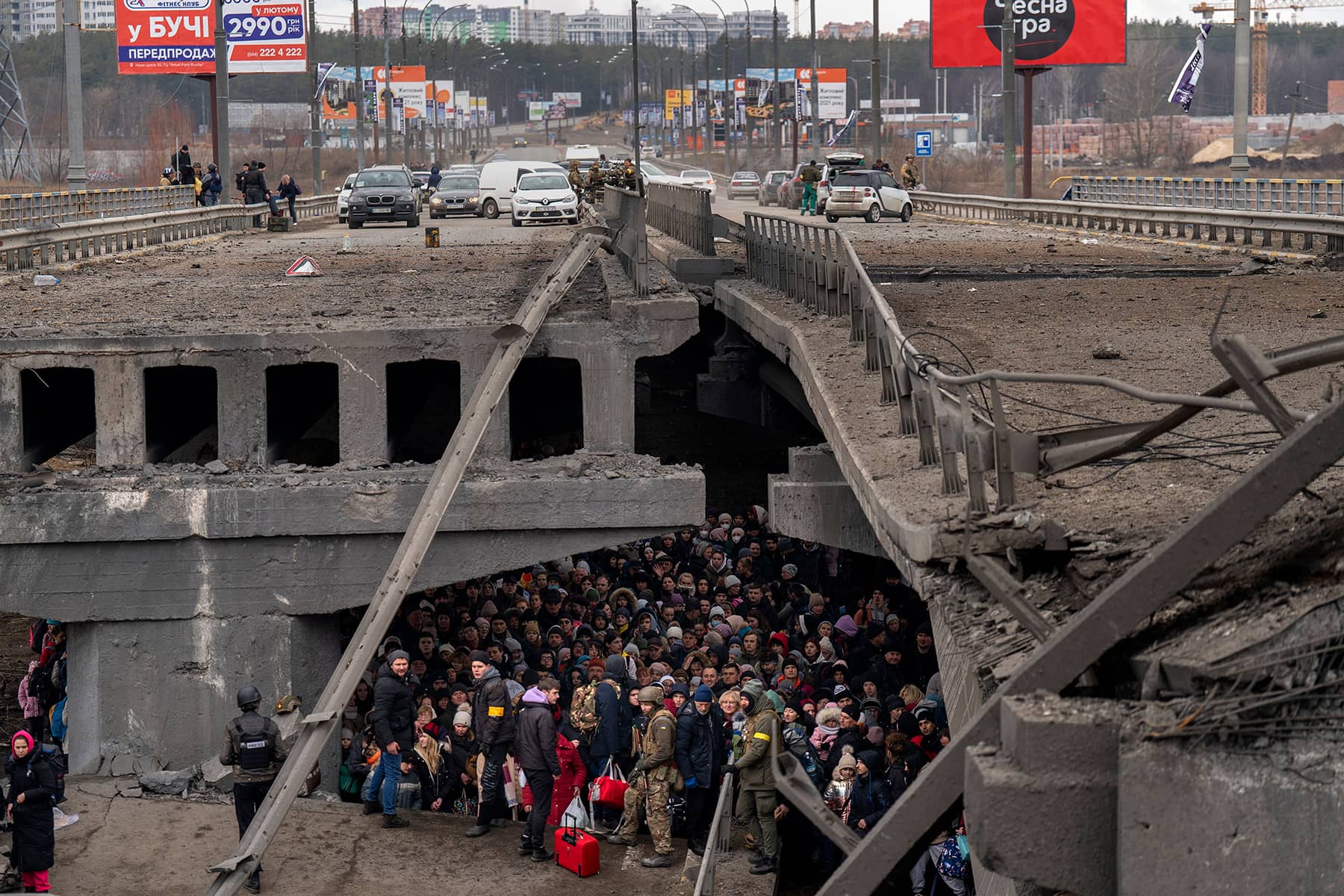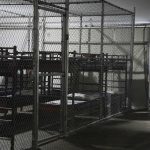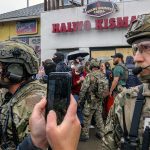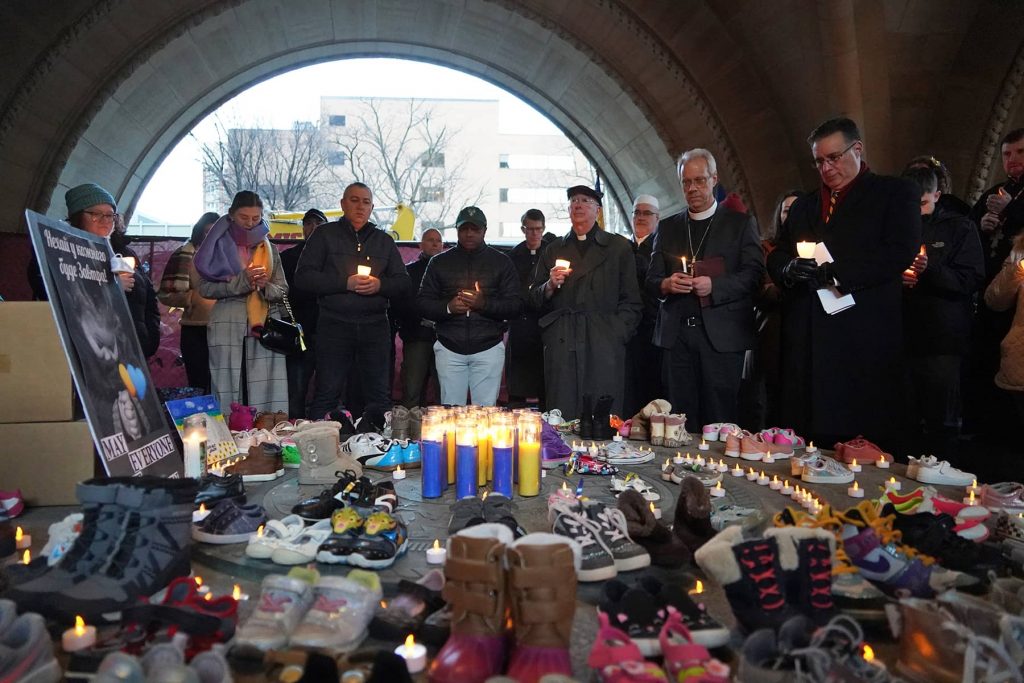
Since Russia’s invasion began in late February 2022, universities, schools, theaters, hospitals, and many other civilian sites in Ukraine have been destroyed by Russian shelling and more than four million people have so far fled the country.
Faced with the devastating consequences of its actions, Russia has increasingly fallen back on a single legal justification: human shields. Indeed, Moscow repeatedly suggested that Ukraine’s military is deliberately using civilians as a screen to defend legitimate military targets.
On February 25, just hours after the invasion began, Russian President Vladimir Putin appealed directly to the personnel of the armed forces of Ukraine: “Do not allow neo-Nazis and [Ukrainian right-wing radical nationalists] to use your children, wives and elders as human shields.”
Echoing his leader, Major General Igor Konashenkov, chief spokesman for the Russian Ministry of Defence, stated in a news conference on February 28 that “the armed forces of the Russian Federation strike only at military targets.” Discussing the capital, Kyiv, he added that “the leadership of Ukraine and the authorities of the city, having announced a curfew, are persuading the residents of the capital to stay in their homes.”
This, he concluded, “once again proves that the Kyiv regime uses the residents of the city as a ‘human shield’ for the nationalists who have deployed artillery units and military equipment in residential areas of the capital.”
Then on March 3, Moscow accused Ukrainian authorities of holding a group of 6,000 Indian students and other foreign nationals as “human shields.” Indian authorities themselves denied the claim. A couple of days later, Putin declared that “the neo-Nazis” were obstructing the creation of humanitarian corridors requested by the Ukrainian government to evacuate civilians trapped in the line of fire, claiming “the militants” were keeping the potential evacuees as human shields.
The shielding accusation
Russia has repeated similar claims in diplomatic arenas such as the United Nations Security Council. On social media too, Russian diplomats have attempted to shape perceptions of the battlefield, portraying the Ukrainian resistance as guilty of war crimes by insisting that they have used “human shields.”
Thus, alongside the war on the ground, we have been witnessing an intense information war, which, as the Russian ambassador at the UN exclaimed, appears to be a vital element of Russia’s so-called “special operation.”
The human shield accusation has actually become an increasingly common defense when states act immorally. As we show in our recent book on human shields, Saudi Arabia, Syria, Israel, Sri Lanka, and India are just some of the states that have deployed the argument to justify high civilian casualties in recent years.
This is partly because legally it appears to be such a useful get-out clause. The legal provision within international law pertaining to human shields states that “the presence or movements of the civilian population or individual civilians shall not be used to render certain points or areas immune from military operations, in particular in attempts to shield military objectives from attacks or to shield, favor or impede military operations.”
According to international law, using human shields constitutes a war crime, while the party responsible for the death of human shields is not the one killing them – if the attack is proportionate – but instead, the one deploying them. Indeed, the very day Russia invaded Ukraine, Human Rights Watch published a Q&A – On Occupation, Armed Conflict and Human Rights – stating that if an attack is proportionate, armed forces can legitimately strike “a military target that is making use of human shields” – though HRW also notes that “it is shielding only when there is a specific intent to use the civilians to deter an attack.”
Hence, by accusing Ukraine of using human shields Russia is in effect claiming that it is not legally responsible for the civilians it kills. And while Russia might be losing the info-war, the legal Trojan Horse of its aggression – the human shielding accusation – is not yet receiving significant opposition. Not merely states, but also human rights organizations have largely failed to voice a consistent critique of the allegations.
When the United States and Sri Lankan governments accused ISIL (ISIS) in Mosul or the Tamil Tigers in the safe zones of using hundreds of thousands of people as human shields, for example, Amnesty International and Human Rights Watch did not dismiss or raise any significant doubts against such narratives.
4.5 million civilians
Once the Russians saw that Western states and human rights organizations were not challenging their allegation that Ukrainians are using human shields, they seem to have decided to up the ante. On March 8, the Russian Defence Ministry accused the Ukrainian “militants” of holding “more than 4.5 million civilians hostage as a human shield.” Basically, Moscow applied its legal argument to 10 percent of the Ukrainian population, transforming millions of civilians into a potentially legitimate target.
This has dramatic consequences. As we have shown in a recent article in the context of the Sri Lankan civil war, prominent legal scholars and investigators have helped rationalize the killing of thousands of innocent people after they had been framed as human shields simply because they were located in proximity to the fighting. The former chief prosecutors in international war crime tribunals, David Crane and Desmond de Silva – who provided their legal opinion to the Sri Lankan government’s commission of investigation on the civil war – argued that killing 12 percent of a group being used as human shields constitutes proportionate killing. If one adopted the same calculations while accepting uncritically the Russian human shielding accusations, then half a million Ukrainian civilians could be killed without violating the law.
There has unfortunately been no real discussion of how, over the past decade, the human shield charge has been routinely used by Israel, Sri Lanka, Russia and other warring parties in numerous theaters of violence as a preemptive legal defense to justify the killing of civilians. In a similar vein, governments have not said anything about this form of legal manipulation.
Decades of repetition, without any significant state or non-state challenge, nor any significant legal scholarship problematizing the use of the human shielding accusation, have created a customary legal consensus whereby the human shields provisions can be used to justify the killing of civilians.
In order to contest the legal arguments that Russia invokes to justify the slaying of innocents, investigative agencies, humanitarian organizations, and human rights groups first need to confront the ease with which warring parties cast hundreds of thousands and at times even millions of civilians as human shields. They failed to do so in Mosul, Gaza, Aleppo, and Sanaa – perhaps in Kyiv, they will finally debunk human shield accusations.
Nеvе Gоrdоn and Nіcоlа Pеrugіnі
Originally published as Why we need to challenge Russia’s human shields narrative














